The Anti-Ageing and Whitening Potential of a Cosmetic Serum Containing 3-O-ethyl-l-ascorbic Acid
Abstract
1. Introduction
2. Materials and Methods
2.1. International Nomenclature of Cosmetic Ingredients (INCI)
2.2. Cell Cultures
2.3. Biocompatibility
2.3.1. Cell Viability (MTT Test)
2.3.2. Skin Irritation Test on 3D Model
2.4. Skin-Ageing
2.4.1. Photoprotective Effect
2.4.2. Collagen Synthesis
2.5. Depigmenting Effect
2.5.1. Cytotoxicity on RHPE (MTT Test)
2.5.2. Melanin Content
2.6. Statistical Analysis
3. Results
3.1. Evaluation of Cell Viability and Skin Irritation
3.2. Protection Against Ultraviolet (UV)B-Induced DNA Damage
3.3. Modulation of Collagen Synthesis
3.4. Evaluation of Melanin Content on Reconstructed Human Pigmented Epidermis (RHPE)
4. Discussion
Author Contributions
Funding
Institutional Review Board Statement
Informed Consent Statement
Data Availability Statement
Conflicts of Interest
References
- Cho-Rong, K.; Young-Min, K.; Min-Kyeong, L.; In-Hye, K.; Youn-Hee, C.; Taek-Jeong, N. Pyropia yezoensis peptide promotes collagen synthesis by activating the TGF-β/Smad signaling pathway in the human dermal fbroblast cell line Hs27. Int. J. Mol. Med. 2017, 39, 31–38. [Google Scholar]
- Cannarozzo, G.; Fazia, G.; Bennardo, L.; Tamburi, F.; Amoruso, G.F.; Del Duca, E.; Nisticò, S.P. A New 675 nm Laser Device in the Treatment of Facial Aging: A Prospective Observational Study. Photomed. Laser Surg. 2021, 39, 118–122. [Google Scholar] [CrossRef] [PubMed]
- Puizina-Ivić, N. Skin aging. Acta Derm. Alp. Pannonica Adriat. 2008, 17, 47–54. [Google Scholar]
- Kohl, E.; Steinbauer, J.; Landthaler, M.; Szeimies, R.-M. Skin ageing. J. Eur. Acad. Dermatol. Venereol. 2011, 25, 873–884. [Google Scholar] [CrossRef] [PubMed]
- Kammeyer, A.; Luiten, R.M. Oxidation events and skin aging. Ageing Res. Rev. 2015, 21, 16–29. [Google Scholar] [CrossRef]
- Nisticò, S.P.; Tolone, M.; Zingoni, T.; Tamburi, F.; Scali, E.; Bennardo, L.; Cannarozzo, G. A New 675 nm Laser Device in the Treatment of Melasma: Results of a Prospective Observational Study. Photomed. Laser Surg. 2020, 38, 1–5. [Google Scholar] [CrossRef]
- Christoph, L.; Sang-In, K.; Steven, E.B.; Arthur, X.L.; Xiwei, W.; Gerd, P.P. UVB irradiation does not directly induce detectable changes of DNA methylation in human keratinocytes. F1000Research 2013, 2, 45. [Google Scholar]
- Vermeer, B.J.; Gilchrest, B.A. A proposal for rational definition, evaluation, and regulation. Arch Dermatol. 1996, 132, 337–340. [Google Scholar] [CrossRef]
- Buono, S.; Langellotti, A.L.; Martello, A.; Bimonte, M.; Tito, A.; Carola, A.; Apone, F.; Colucci, G.; Fogliano, V. Biological activities of dermatological interest by the water extract of the microalga Botryococcus braunii. Arch Dermatol Res. 2012, 304, 755–764. [Google Scholar] [CrossRef]
- Iliopoulosa, F.; Silb, B.C.; Moorec, D.J.; Lucasc, R.A.; Lanea, M.E. 3-O-ethyl-l-ascorbic acid: Characterisation and investigation of single solvent systems for delivery to the skin. Int. J. Pharm. X 2019, 1, 100025. [Google Scholar] [CrossRef]
- Nusgens, B.V.; Humbert, P.; Rougier, A.; Colige, A.C.; Haftek, M.; Lambert, C.A.; Richard, A.; Creidi, P.; Lapière, C.M. Topically applied vitamin C enhances the mRNA level of collagens I and III, their processing enzymes and tissue inhibitor of matrix metalloproteinase 1 in the human dermis. J. Investig. Dermatol. 2001, 116, 853–859. [Google Scholar] [CrossRef] [PubMed]
- Haftek, M.; Mac-Mary, S.; le Bitoux, M.; Creidi, P.; Seité, S.; Rougier, A.; Humbert, P. Clinical, biometric and structural evaluation of the long-term effects of a topical treatment with ascorbic acid and madecassoside in photoaged human skin. Exp. Dermatol. 2008, 17, 946–952. [Google Scholar] [CrossRef]
- Ganceviciene, R.; Liakou, A.I.; Theodoridis, A.; Makrantonaki, E.; Zouboulis, C.C. Skin anti-aging strategies. Dermatoendocrinology 2012, 4, 308–319. [Google Scholar] [CrossRef]
- Stamford, N.P. Stability, transdermal penetration, and cutaneous effects of ascorbic acid and its derivatives. J. Cosmet. Dermatol. 2012, 11, 310–317. [Google Scholar] [CrossRef] [PubMed]
- Caritá, A.C.; Fonseca-Santos, B.; Shultz, J.D.; Michniak-Kohn, B.; Chorilli, M.; Leonardi, G.R. Vitamin C: One compound, several uses. Advances for delivery, efficiency and stability. Nanomedicine 2020, 24, 102117. [Google Scholar] [CrossRef]
- Pullar, J.; Carr, A.; Vissers, M. The roles of vitamin C in skin health. Nutrients 2017, 9, 866. [Google Scholar] [CrossRef]
- De Dormael, R.; Bastien, P.; Sextius, P.; Gueniche, A.; Ye, D.; Tran, C.; Chevalier, V.; Gomes, C.; Souverain, L.; Tricaud, C. Vitamin C Prevents Ultraviolet-induced Pigmentation in Healthy Volunteers: Bayesian Meta-analysis Results from 31 Randomized Controlled versus Vehicle Clinical Studies. J. Clin. Aesthet. Dermatol. 2019, 12, E53–E59. [Google Scholar]
- Tai, A.; Aburada, M.; Ito, H. A simple efficient synthesis and biological evaluation of 3-O-ethylascorbic acid. Biosci. Biotechnol. Biochem. 2014, 78, 1984–1987. [Google Scholar] [CrossRef]
- Tang, S.-C.; Yang, J.-H. Dual Effects of Alpha-Hydroxy Acids on the Skin. Molecules 2018, 23, 863. [Google Scholar] [CrossRef] [PubMed]
- Sharad, J. Glycolic acid peel therapy—A current review. Clin. Cosmet. Investig. Dermatol. 2013, 6, 281–288. [Google Scholar] [CrossRef]
- Kornhauser, A.; Coelho, S.G.; Hearing, V.J. Effects of cosmetic formulations containing hydroxyacids on sun-exposed skin: Current applications and future developments. Dermatol. Res. Pract. 2012, 2012, 710893. [Google Scholar] [CrossRef] [PubMed]
- Kandárová, H.; Liebsch, M.; Schmidt, E.; Genschow, E.; Traue, D.; Spielmann, H.; Meyer, K.; Steinhoff, C.; Tornier, C.; de Wever, B.; et al. Assessment of the skin irritation potential of chemicals by using the SkinEthic reconstructed human epidermal model and the common skin irritation protocol evaluated in the ECVAM skin irritation validation study. Altern. Lab. Anim. 2006, 34, 393–406. [Google Scholar] [CrossRef] [PubMed]
- Kandárová, H.; Liebsch, M.; Spielmann, H.; Genschow, E.; Schmidt, E.; Traue, D.; Guest, R.; Whittingham, A.; Warren, N.; Gamer, A.O.; et al. Assessment of the human epidermis model SkinEthic RHE for in vitro skin corrosion testing of chemicals according to new OECD TG 431. Toxicol. In Vitro 2006, 20, 547–559. [Google Scholar] [CrossRef] [PubMed]
- Rosdy, M.; Clauss, L.C. Terminal epidermal differentiation of human keratinocytes grown in chemically defined medium on inert filter substrates at the air-liquid interface. J. Investig. Dermatol. 1990, 95, 409–414. [Google Scholar] [CrossRef] [PubMed]
- Van Merloo, J.; Kaspers, G.J.; Cloos, J. Cell sensitivity assays: The MTT assay. Methods Mol. Biol. 2011, 731, 237–245. [Google Scholar]
- ISO. Biological Evaluation of Medical Devices–Part 10: Test for Irritation and Skin Sensitization (ISO 10993-10:2012); ISO: London, UK, 2012. [Google Scholar]
- Ramata-Stunda, A.; Boroduskis, M.; Vorobjeva, V.; Ancans, J. Cell and tissue culture-based in vitro test systems for evaluation of natural skin care product ingredients. Environ. Exp. Biol. 2013, 11, 159–177. [Google Scholar]
- Edmondson, R.; Jenkins Broglie, J.; Adcock, A.F.; Yang, L. Three-dimensional cell culture systems and their applications in drug discovery and cell-based biosensors. Assay Drug Dev. Technol. 2014, 12, 207–218. [Google Scholar] [CrossRef]
- Sotiropoulou, G.; Zingkou, E.; Pampalakis, G. Redirecting drug repositioning to discover innovative cosmeceuticals. Exp. Dermatol. 2021, 30, 628–644. [Google Scholar] [CrossRef]
- Sun, Y.; Wang, P.; Li, H.; Dai, J. BMAL1 and CLOCK proteins in regulating UVB-induced apoptosis and DNA damage responses in human keratinocytes. J. Cell Physiol. 2018, 233, 9563–9574. [Google Scholar] [CrossRef]
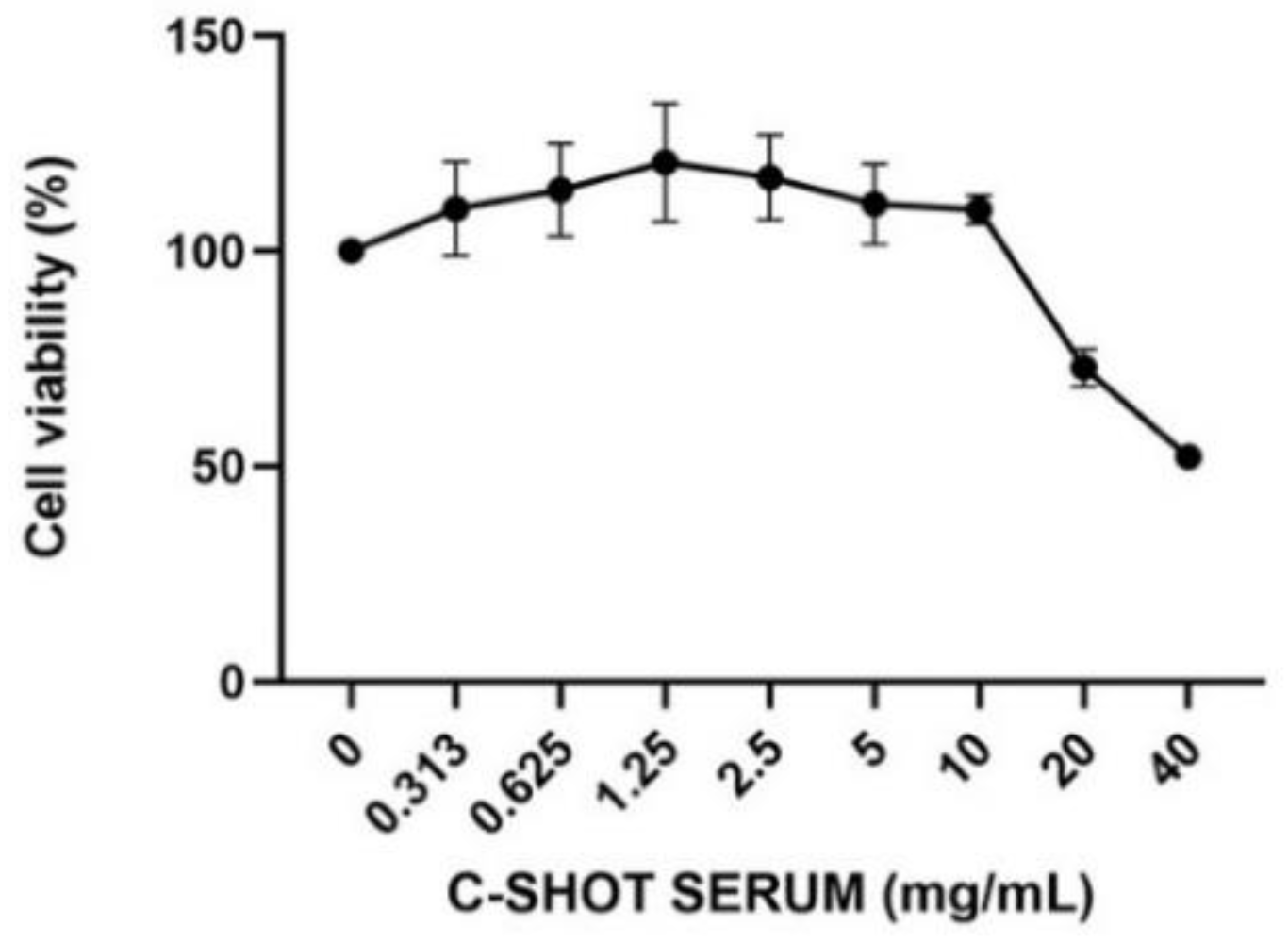
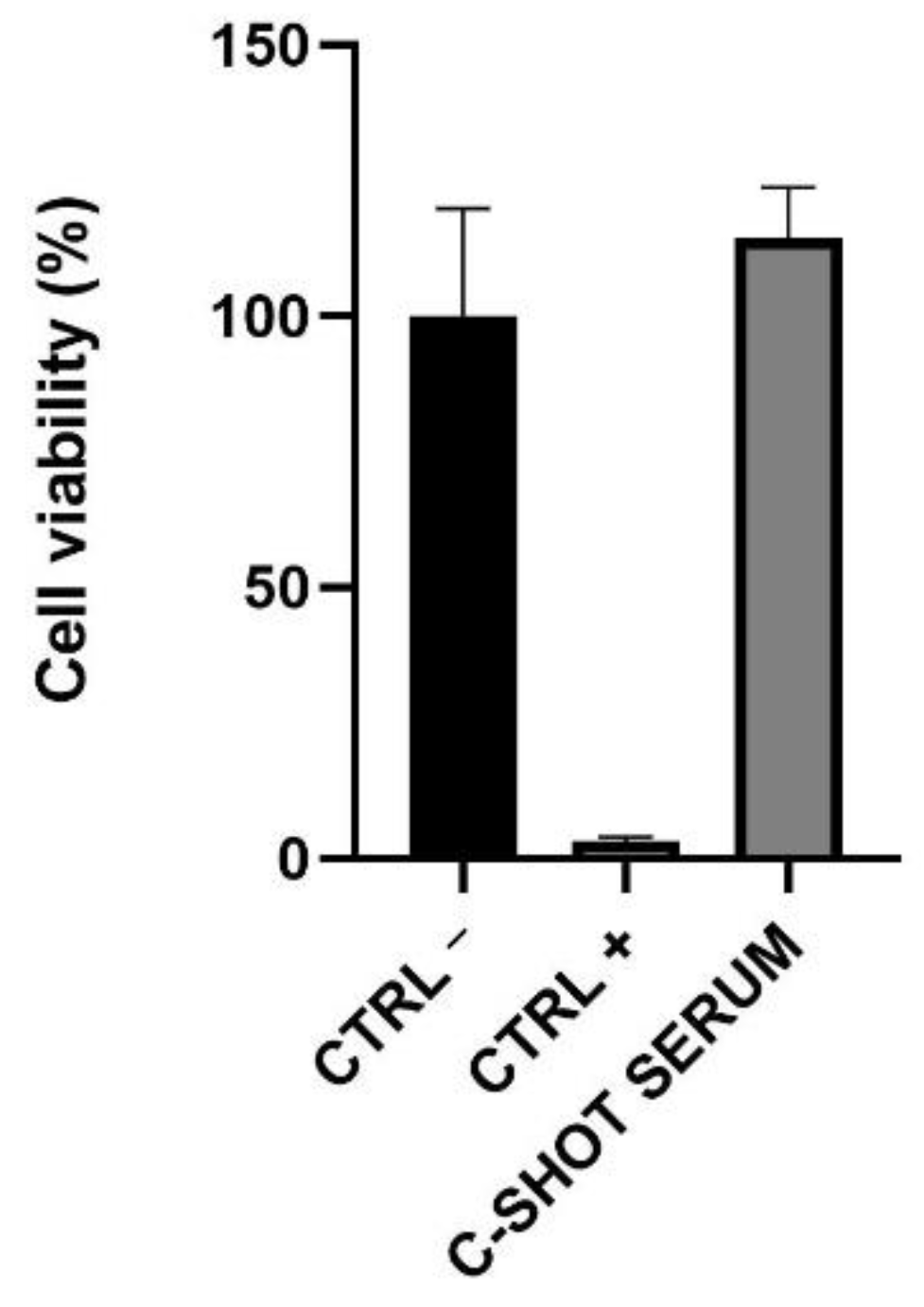
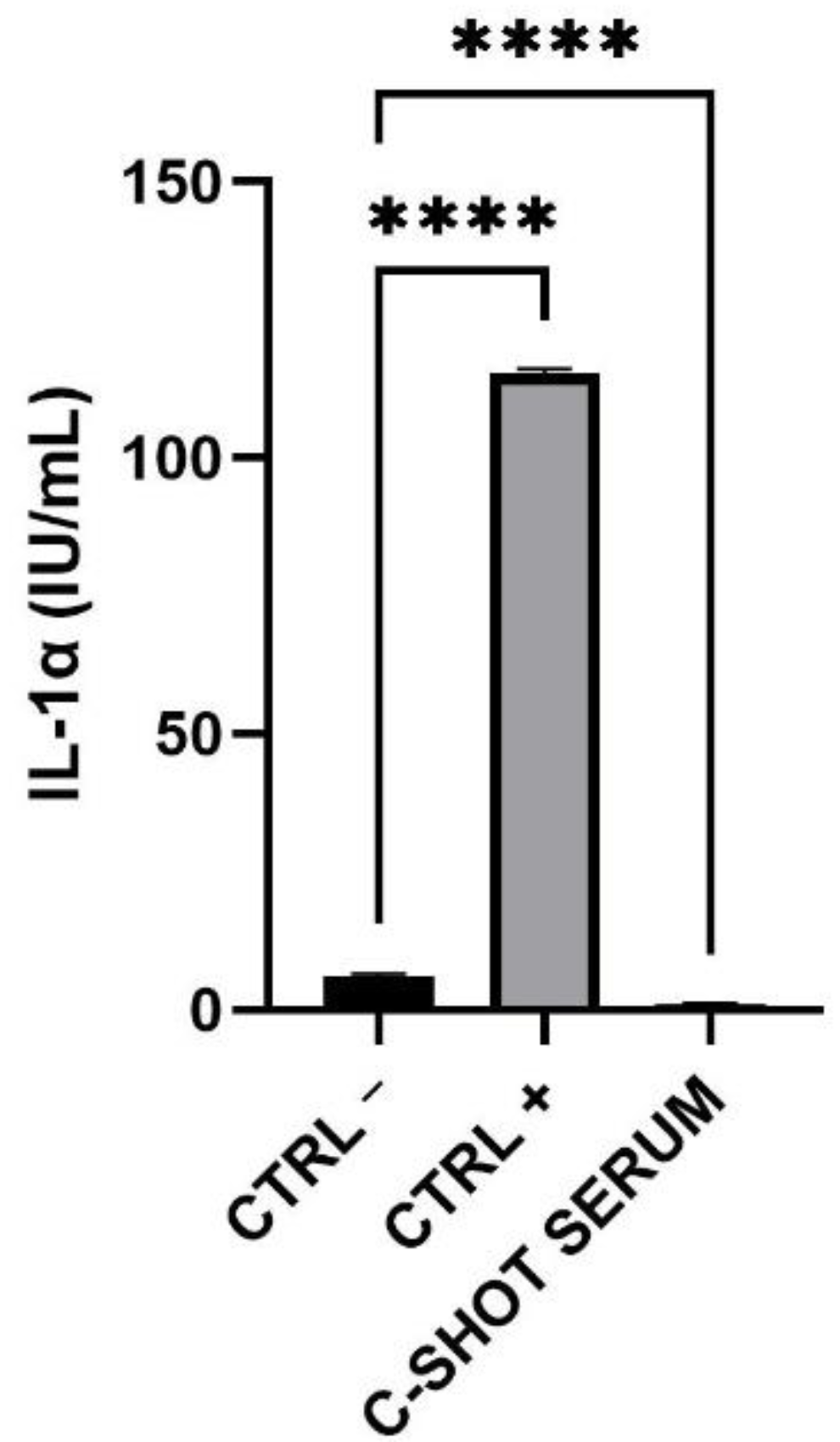


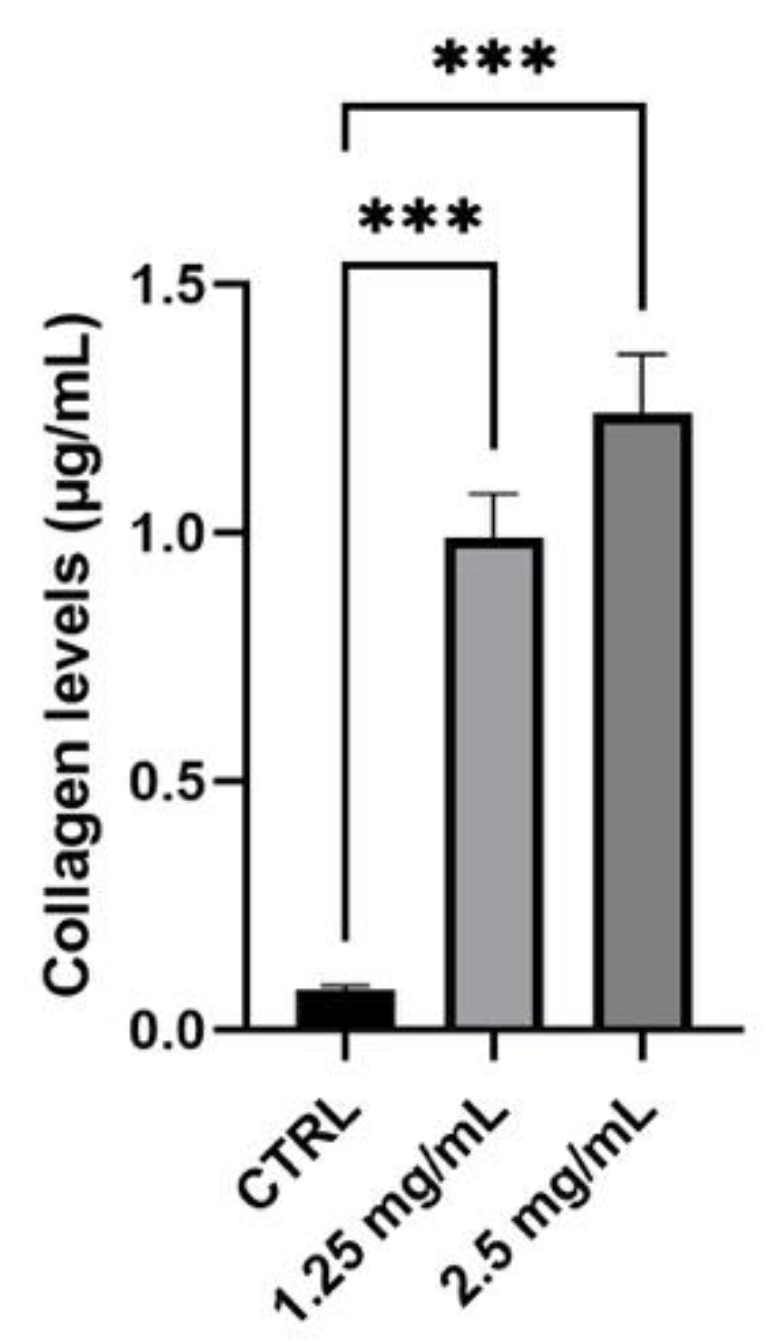
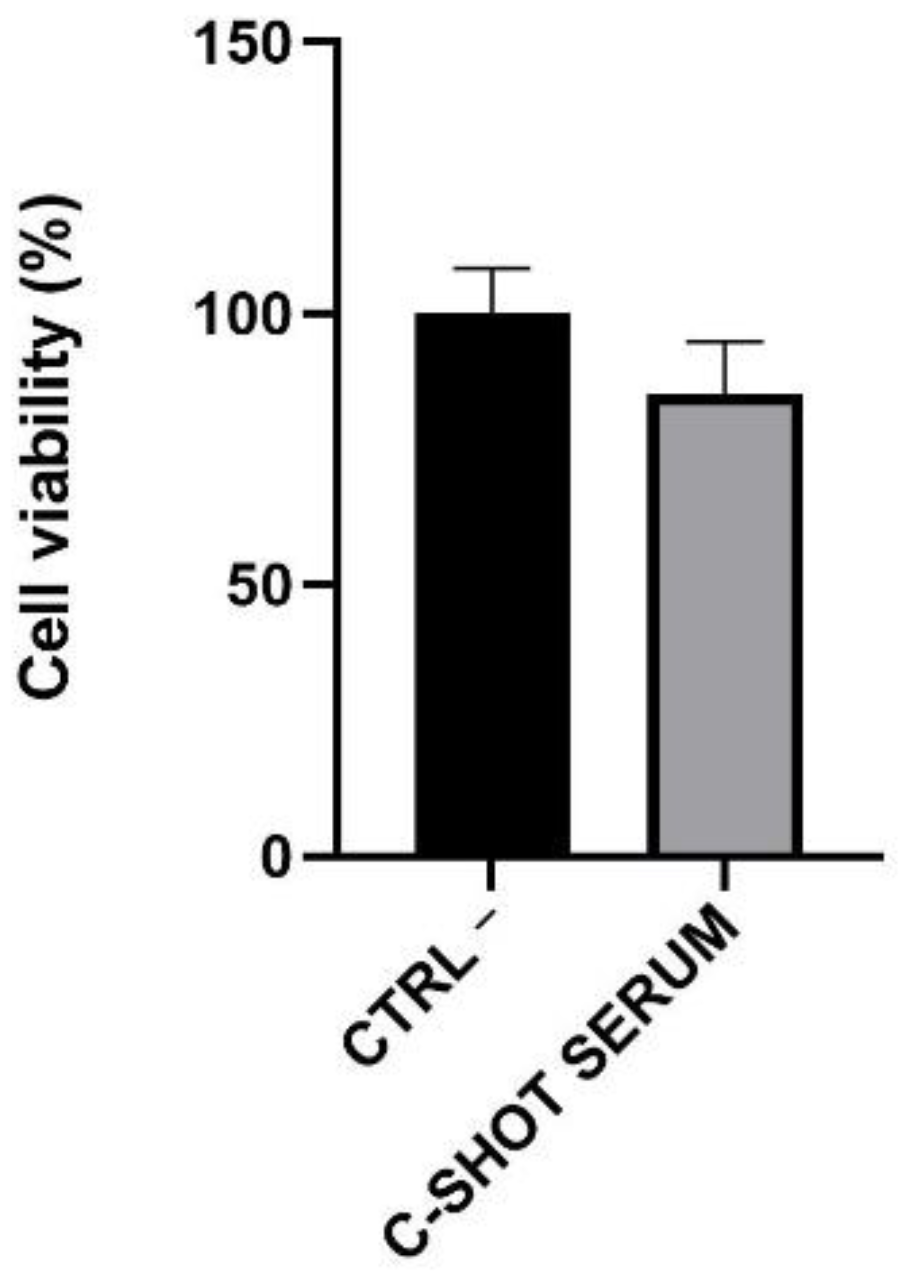
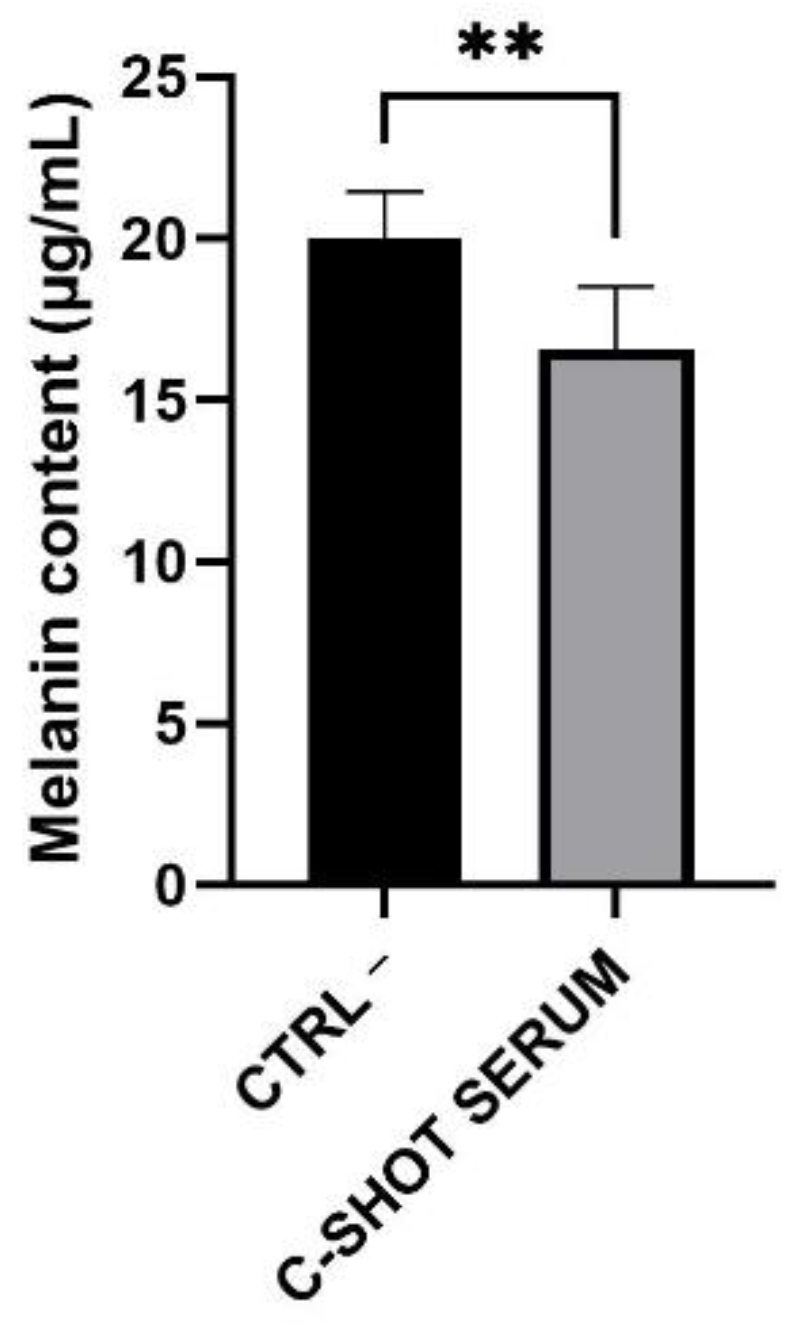
| Function | Ingredient |
|---|---|
| Skin conditioning | 3-O-ethyl ascorbic acid, lactic acid |
| Humectant | propanediol, sodium lactate |
| Buffering & Keratolytic | sodium lactate |
| Preservative | phenoxyethanol, imidazolidinyl urea |
| Thickener | hydroxyethylcellulose |
| Chelating agent | disodium edta |
| Maintenance Media | Growth Media | |
|---|---|---|
| RHE (19-RHE-036) | 19SMM010 | 19SGM026 |
| RHPE (19-RHPE-019) | 19SMM019 | 19SGMRHPE013 |
| Sample (mg/mL) | 0 | 0.313 | 0.625 | 1.25 | 2.50 | 5 | 10 | 20 | 40 |
| Cell Viability (%) | 100 | 109.78 | 114.20 | 120.52 | 117.04 | 110.91 | 109.60 | 72.89 | 52.18 |
| Standard Deviation (SD) | 0 | 10.86 | 10.71 | 13.69 | 9.89 | 9.31 | 3.29 | 4.30 | 0.93 |
| IC50 Value | 0.93 * | ||||||||
| Sample | Cell Viability (%) |
|---|---|
| Ctrl − | 100 ± 19.75 |
| Ctrl + | 3.17 ± 0.81 |
| C-SHOT SERUM | 114.34 ± 9.35 |
| Sample | IL-1α (IU/mL) |
|---|---|
| Ctrl − | 5.90 ± 0.65 |
| Ctrl + | 115.27 ± 0.83 |
| C-SHOT SERUM | 0.98 ± 0.17 |
| Sample | γ-H2AX Positive Cells (%) |
|---|---|
| Ctrl | 6.15 ± 2.82 |
| Ctrl + | 65.70 ± 2.51 |
| C-SHOT SERUM (5 mg/mL) | 49.87 ± 5.36 |
| C-SHOT SERUM (10 mg/mL) | 52.83 ± 11.40 |
| Sample | Collagen Levels (μg/mL) |
|---|---|
| Ctrl | 0.08 ± 0.01 |
| C-SHOT SERUM (1.25 mg/mL) | 0.99 ± 0.09 |
| C-SHOT SERUM (2.5 mg/mL) | 1.24 ± 0.12 |
| Sample | Melanin Content (μg/mL) | Melanin Content (%) | Reduction (%) |
|---|---|---|---|
| Ctrl − | 20.02 ± 1.43 | 100.00 ± 8.03 | - |
| C-SHOT SERUM | 16.60 ± 1.92 | 82.89 ± 9.57 | −17.10 |
Publisher’s Note: MDPI stays neutral with regard to jurisdictional claims in published maps and institutional affiliations. |
© 2021 by the authors. Licensee MDPI, Basel, Switzerland. This article is an open access article distributed under the terms and conditions of the Creative Commons Attribution (CC BY) license (https://creativecommons.org/licenses/by/4.0/).
Share and Cite
Zerbinati, N.; Sommatis, S.; Maccario, C.; Di Francesco, S.; Capillo, M.C.; Rauso, R.; Herrera, M.; Bencini, P.L.; Guida, S.; Mocchi, R. The Anti-Ageing and Whitening Potential of a Cosmetic Serum Containing 3-O-ethyl-l-ascorbic Acid. Life 2021, 11, 406. https://doi.org/10.3390/life11050406
Zerbinati N, Sommatis S, Maccario C, Di Francesco S, Capillo MC, Rauso R, Herrera M, Bencini PL, Guida S, Mocchi R. The Anti-Ageing and Whitening Potential of a Cosmetic Serum Containing 3-O-ethyl-l-ascorbic Acid. Life. 2021; 11(5):406. https://doi.org/10.3390/life11050406
Chicago/Turabian StyleZerbinati, Nicola, Sabrina Sommatis, Cristina Maccario, Serena Di Francesco, Maria Chiara Capillo, Raffaele Rauso, Martha Herrera, Pier Luca Bencini, Stefania Guida, and Roberto Mocchi. 2021. "The Anti-Ageing and Whitening Potential of a Cosmetic Serum Containing 3-O-ethyl-l-ascorbic Acid" Life 11, no. 5: 406. https://doi.org/10.3390/life11050406
APA StyleZerbinati, N., Sommatis, S., Maccario, C., Di Francesco, S., Capillo, M. C., Rauso, R., Herrera, M., Bencini, P. L., Guida, S., & Mocchi, R. (2021). The Anti-Ageing and Whitening Potential of a Cosmetic Serum Containing 3-O-ethyl-l-ascorbic Acid. Life, 11(5), 406. https://doi.org/10.3390/life11050406








